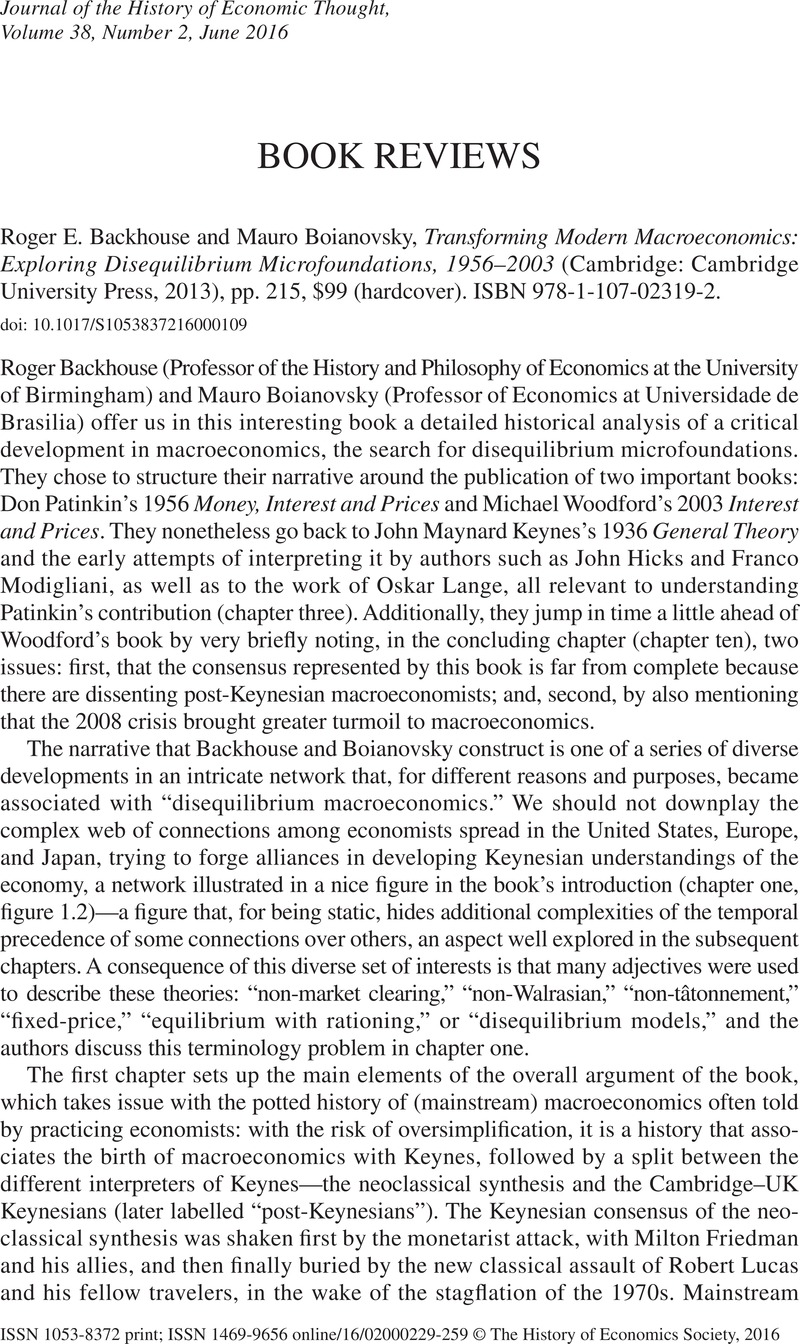No CrossRef data available.
Article contents
Roger E. Backhouse and Mauro Boianovsky, Transforming Modern Macroeconomics: Exploring Disequilibrium Microfoundations, 1956–2003 (Cambridge: Cambridge University Press, 2013), pp. 215, $99 (hardcover). ISBN 978-1-107-02319-2.
Review products
Roger E. Backhouse and Mauro Boianovsky, Transforming Modern Macroeconomics: Exploring Disequilibrium Microfoundations, 1956–2003 (Cambridge: Cambridge University Press, 2013), pp. 215, $99 (hardcover). ISBN 978-1-107-02319-2.
Published online by Cambridge University Press: 11 May 2016
Abstract
An abstract is not available for this content so a preview has been provided. Please use the Get access link above for information on how to access this content.

- Type
- Book Reviews
- Information
- Copyright
- Copyright © The History of Economics Society 2016
References
REFERENCES
Boumans, Marcel. 2002. “Calibration.” In Snowdon, Brian and Vane, Howard R., eds., An Encyclopedia of Macroeconomics. Cheltenham: Edward Elgar, pp. 105–109.Google Scholar
Boumans, Marcel. 2005. How Economists Model the World into Numbers. London: Routledge.Google Scholar
Christiano, Lawrence J., Eichenbaum, Martin, and Evans, Charles L.. 2005. “Nominal Rigidities and the Dynamic Effects of a Shock to Monetary Policy.”
Journal of Political Economy
113 (1): 1–45.Google Scholar
Duarte, Pedro Garcia. 2011. “Recent Developments in Macroeconomics: The DSGE Approach to Business Cycles in Perspective.” In Davis, John B. and Wade Hands, D., eds., The Elgar Companion to Recent Economic Methodology. Cheltenham, UK: Edward Elgar, pp. 375–403.Google Scholar
Duarte, Pedro Garcia. 2012. “Not Going Away? Microfoundations in the Making of a New Consensus in Macroeconomics.” In Davis, John B. and Wade Hands, D., eds., The Elgar Companion to Recent Economic Methodology. Cheltenham, UK: Edward Elgar, pp. 190–237.Google Scholar
Duarte, Pedro Garcia, and Lima, Gilberto Tadeu, eds. 2012. Microfoundations Reconsidered—The Relationship of Micro and Macroeconomics in Historical Perspective. Cheltenham, UK: Edward Elgar.Google Scholar
Hart, Oliver D. 1982. “A Model of Imperfect Competition with Keynesian Features.”
Quarterly Journal of Economics
97 (1): 109–138.CrossRefGoogle Scholar
Hoover, Kevin D. 2010. “Idealizing Reduction: The Microfoundations of Macroeconomics.”
Erkenntnis
73 (3): 329–347.Google Scholar
King, John. 2012. The Microfoundations Delusion—Metaphor and Dogma in the History of Macroeconomics. Cheltenham, UK: Edward Elgar.CrossRefGoogle Scholar
Kydland, Finn, and Prescott, Edward. 1991. “The Econometrics of the General Equilibrium Approach to Business Cycles.”
Scandinavian Journal of Economics
93 (2): 161–178.CrossRefGoogle Scholar
Mankiw, N. Gregory. 1989. “Real Business Cycle: A New Keynesian Perspective.”
Journal of Economic Perspectives
3 (3): 79–90.Google Scholar
Mankiw, N. Gregory, and Romer, David, eds. 1991. New Keynesian Economics. Two volumes. Cambridge, MA: MIT Press.Google Scholar
Morgan, Mary. 2012. The World in the Model: How Economists Work and Think. Cambridge: Cambridge University Press.Google Scholar
Sent, Esther-Mirjam. 2002. “How (Not) to Influence People: The Contrary Tale of John F. Muth.”
HOPE
34 (2): 291–320.Google Scholar
Sims, Christopher A. 1996. “Macroeconomics and Methodology.”
Journal of Economic Perspectives
10 (1): 105–120.CrossRefGoogle Scholar
Smets, Frank, and Wouters, Raf. 2003. “An Estimated Dynamic Stochastic General Equilibrium Model of the Euro Area.”
Journal of the European Economic Association
1 (5): 1123–1175.Google Scholar
Weintraub, E. Roy, and Mirowski, Philip. 1994. “The Pure and the Applied: Bourbakism Comes to Mathematical Economics.”
Science in Context
7 (2): 245–272.Google Scholar


